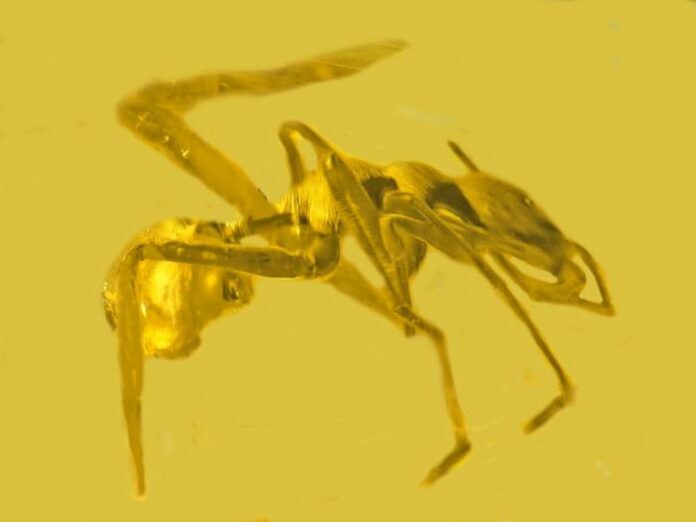Scientists have discovered a new prehistoric species of spider with a genius strategy for hiding from its predators.
Spiders are not well preserved in the fossil record because of their soft exoskeletons, so our understanding of these ancient arachnids is fairly limited. But in rare cases, spiders can become trapped in various tree resins, such as amber and copal, preserving their bodies for millennia.
Even more unusual is finding a fossilized spider masquerading as something else—in this case, an ant.
In a study published in the journal Historical Biology, paleobiologist George Poinar Junior, who has a courtesy appointment in the Oregon State University College of Science, presents an early record of a newly discovered species of the ant-mimicking spider Myrmarachne colombiana.
GEORGE POINAR JR./Getty
As the name suggests, the new species was discovered in Colombia in South America, encapsulated in a block of copal resin. The exact age of the specimen is still unclear as attempting to date the resin could risk damaging the spider’s delicate remains, but copal fossils can be up to 3 million years old. But its age is not its most interesting feature.
Pretending to be an ant is a common tactic among spiders to escape predation. However, according to Poinar, there is no record of ant-mimickry among spiders in Colombia. But why would spiders want to pretend to be ants in the first place?
“Ants are particularly good creatures for spiders to pretend to be [because] many animals find ants distasteful or dangerous to eat,” Poinar said in a statement. “Ants are aggressive in their own defense—they have a strong bite as well as a stinging venom, and they can call in dozens of nestmates as allies.
“Spiders, meanwhile, have no chemical defenses and are loners, which makes them vulnerable to being hunted by larger spiders, wasps and birds—predators that would rather avoid ants. So, if a spider can be like an ant, it’s more likely to be unbothered.”
So how does a spider, with its eight legs and lack of antennae, disguise itself as an ant?
“It is a challenge for spiders to accomplish this magical transformation to ants,” Poinar said.
Typically, spiders position their extra legs to jut out from the front of their body, thus resembling a creature with six legs and two antennae. But legs are not the only things that separate ants and arachnids.
“The abdomen and cephalothorax of spiders are closely attached, while in ants the equivalent of these body parts are separated by a narrow segment called the petiole,” Poinar said. “And there are many other lesser structures that need to be modified in spiders for them to closely resemble ants. How is this accomplished? Most scientists say it begins with spider mutation, adaptation and then natural selection.”
However, Poinar believes that there may be some level of higher intelligence among these masquerading mini beasts.
Either way, specimens like this provide an important piece of the evolutionary puzzle of how these complex adaptations evolved and give us important insight into the biology of modern-day species.
Uncommon Knowledge
Newsweek is committed to challenging conventional wisdom and finding connections in the search for common ground.
Newsweek is committed to challenging conventional wisdom and finding connections in the search for common ground.


